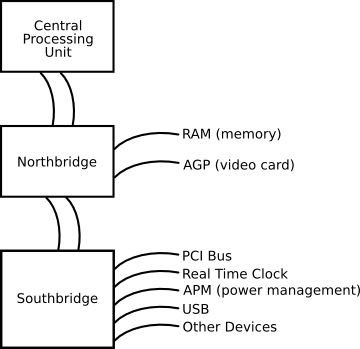Northbridge (computing)

The northbridge, also known as the Memory Controller Hub (MCH), is traditionally one of the two chips in the core logic chipset on a PC motherboard, the other being the Southbridge. Separating the chipset into Northbridge and Southbridge is common, although there are rare instances where these two chips have been combined onto one die when design complexity and fabrication processes permit it.
Overview
The northbridge typically handles communications between the CPU, RAM, AGP or PCI Express, and the southbridge. Some northbridges also contain integrated video controllers, which are also known as a Graphics and Memory Controller Hub (GMCH). Because different processors and RAM require different signalling, a northbridge will typically work with only one or two classes of CPUs and generally only one type of RAM. There are a few chipsets that support two types of RAM (generally these are available when there is a shift to a new standard). For example, the northbridge from the NVIDIA nForce2 chipset will only work with Duron, Athlon, and Athlon XP processors combined with DDR SDRAM, the Intel i875 chipset will only work with systems using Pentium 4 processors or Celeron processors that have a clock speed greater than 1.3 GHz and utilize DDR SDRAM, and the Intel i915g chipset only works with the Intel Pentium 4 and the Intel Celeron, but it can use DDR or DDR2 memory.
Etymology
The name is derived from drawing the architecture in the fashion of a map. The CPU would be at the top of the map at due north. The CPU would be connected to the chipset via a fast bridge (the northbridge) located north of other system devices as drawn. The northbridge would then be connected to the rest of the chipset via a slow bridge (the southbridge) located south of other system devices as drawn.

Importance
The northbridge on a particular system's motherboard is the most prominent factor in dictating the number, speed, and type of CPU(s) and the amount, speed, and type of RAM that can be used. Other factors such as voltage regulation and available number of connectors also play a role. Virtually all consumer-level chipsets support only one processor series, with the maximum amount of RAM varying by processor type and motherboard design. Pentium-era machines often had a limitation of 128 MB, while Pentium 4 machines have a limit of 4 GB. Since the Pentium Pro, the Intel architecture can accommodate physical addresses larger than 32 bits, typically 36 bits, which give up to 64 GB of addressing, though motherboards that can support that much RAM are rare because of other factors (operating system limitations and expense of RAM).
A northbridge typically will only work with one or two different southbridge ASICs; in this respect, it affects some of the other features that a given system can have by limiting which technologies are available on its southbridge partner.
Recent developments
The memory controller, which handles communication between the CPU and RAM, has been moved onto the processor die in AMD64 processors. Other CPU designers have considered this change for their own product lines, such as Intel and IBM.
An example of this change is NVIDIA's nForce3 chipset for AMD64 systems that is a single chip. It combines all of the features of a normal southbridge with an AGP port and connects directly to the CPU. On nForce4 boards they consider this to be a MCP (Media Communications Processor).
For the future a SOC/single chip solution is always more popular due to the lower component count at the assembly stage. However, larger chips may reduce the versatility of the solution and have higher complexity and pin count. This caveat is currently less important because many of the recent high speed buses (PCIe, SATA) are serial in nature and highly programmable. This is likely to bring a return of a standard implementation connected via a standard bus (probably PCIe) which could be merged into the Super I/O controller. On the other hand, the Super I/O can be left as is and the pins not used for the AGP controller may be available for a different integration consisting of Graphic processor, PCI express, SATA, USB, IDE, SDIO card reader, PC Card/CardBus, PCI controller.
Northbridge and overclocking
The Northbridge plays an important part in how far a computer can be overclocked, as its frequency is used as a baseline for the CPU to establish its own operating frequency. In today's machines, the chip is becoming increasingly hotter as computers become faster. It is not unusual for the northbridge to now use some type of heatsink or active cooling.
